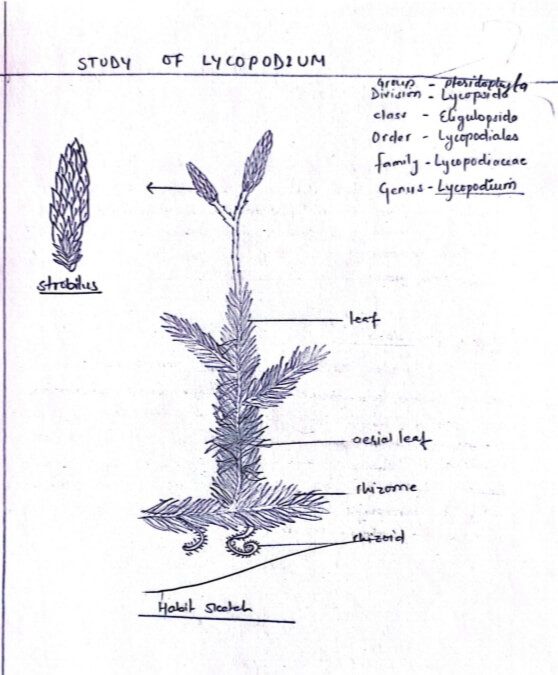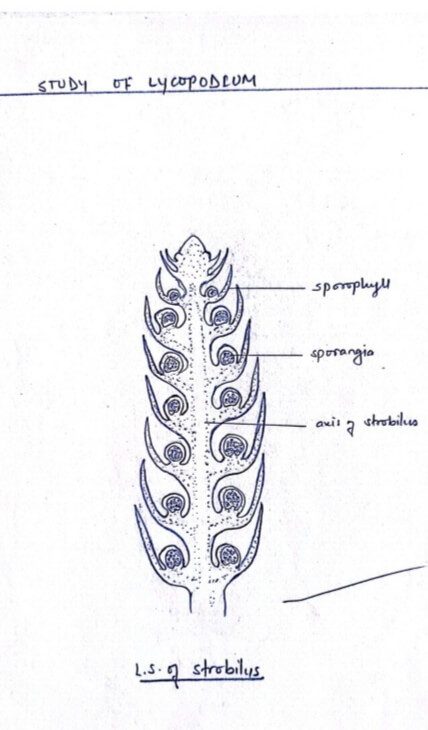COMMENT ON LYCOPODIUM
Habit
i) Club moss:
Lycopodium is a cosmopolitan, evergreen, perennial prostrate or pendant shrubby herb growing in the humus soil of Moist shady places in tropical, subtropical, terrestrial or temperate regions. Because of their moss-like appearance and presence of club- shaped strobilus, they are commonly known as club-moss, ground picnics of trailing evergreen.
ii) Lycopodium clavatum:
It is a terrestrial species growing on humus moist soil. It belongs to the sub-genus Rhopalostachya due to the prostate and creeping habit. It is partially or completely subterranean but the main axis of the rhizome gives off upright aerial branches. It shows an unequal dichotomy with short branch bearing strobili first and long branch after a certain distance only. The sporophyll bearing shoots that bear sporangia are distinct from sterile regions.

Internal structure of root
i) Epidermis:
It is a thin walled single called outermost layer without cuticle but some cells produce a pair of unicellular roof hairs.
ii) Cortex:
Underneath the epidermis layer there lies a broad Cortical layer divisible into upper 1-4 layers of sclerenchymatous hypodermis and lower thin walled multi layered parenchymatous région.
iii)Pericycle and endodermis:
Inconspicuous or not clearly visible.
Stele:- It may be monarch, diarch, tetra or polyarch. The prostrate and creeping type bear polyarch stele with a number of xylem plates arranged in radial rows. The metaxylem of each radial plate unite to give ster-shaped but in most cases, the stele is diarch with the protoxylem of their tip. It forms C or U-shaped because of the united metaxylem.
Pith:- Absent.
Internal structure of leaf
i) Epidermis:-
The leaf is externally bonded by a distinct upper and lower layer composed of thin walled cells interrupted by some stomata.
ii) Mesophyll tissue:-
The space between upper and lower epidermis and vascular bundle is occupied by undifferentiated polygonal chlorenchymatous cells enclosing large intercellular space.
iii) Endodermis:-
Inconspicuous
iv) Pericycle:-
The midrib bundle is ensheathed by a sclerenchymatous pericycle.
v) Vascular bundle:
It is represented by a single concentric amphicribral small vascular bundle consisting of small central xylem surrounded by phloem.

Internal structure of stem.
i) Epidermis:
The outermost wall is composed of a single celled layer whose external wall is cutinized to form a cuticle.
ii) Cortex:
It is a thick layer below the epidermis that may show homogeneous mass of parenchymatous cells with intercellular spaces or sclerenchymatous cells without enclosing intercellular space.
iii) Endodermis:
It is a distinct layer composed of a single barrel- shaped cell layer having a casparian strip on the radial walls.
iv) Pericycle:
Inner to endodermis lies 2-4 thick layers of compactly amorpeal parenchymatous cells.
v) stele:
Basically, it is a protostelic stele type consisting of a central xylem surrounded by phloem. The xylem is exarch with protoxylem consisting of annular-spiral tracheids and metaxylem with that of scalariform tracheids. The phloem consists of sieve tube and phloem parenchyma.

Asexual reproductive structure
i) Strobili:
The asexual reproductive spores are borne in strobili localized of the apices of erect stack-like branches called podia. They are covered with minute scaly leaves. Each strobilus consists of a central axis surrounded by a number of acutely pointed sporophylls. Each sporophyll bean has a large blackish single sporangium af adaxial side near the base.
ii) Sporangium:
It consists of a kidney shaped body standing on a massive stalk. The body is covered by a multilayered sporangial wall enclosing numerous uniform sized spores showing homosporous Condition.
iii) Spore:
It is tetrahedral in shape enveloped by double layered wall outer granular exine and inner thin intine.

